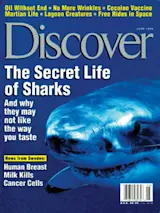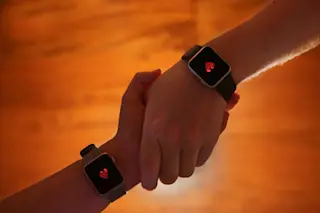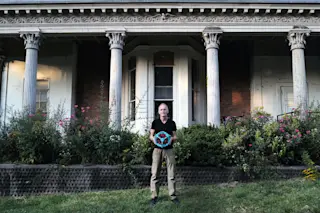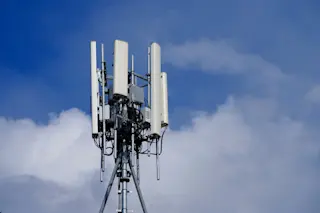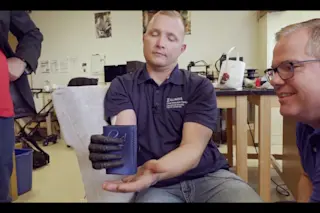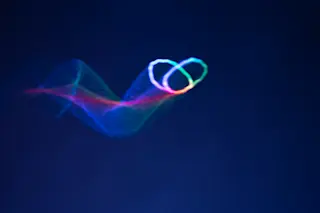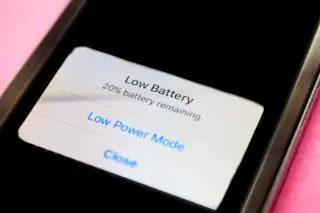If there are human beings on Earth in the year 52,001, and they happen to look to the northern sky one evening and find it filled with a shimmering aurora, they can thank Jean-Marc Philippe for the light show. Philippe, an artist in Paris, is the creator of KEO, a satellite designed to stay in orbit for 50,000 years. When KEO finally plunges back into the atmosphere, an ice age or so from now, its disintegrating heat shield will generate spectacular streamers of light--"to alert our descendants that something abnormal has happened," says Philippe. As the northern lights fade, KEO's core, a small titanium sphere, will fall to Earth somewhere, intact. Inside will be letters from us.
Philippe hopes to collect billions of letters, store them on compact disks in that titanium sphere, and launch them in 2001. Because KEO is meant to be a work of art, it will have giant wings that will flap for a few years after its launch. Their sole purpose is to be beautiful.
Some frequently asked questions about this plan include: Could someone who is not French have thought of it? Perhaps not. But the same could be said of the Eiffel Tower, hot-air balloons, and many other sublime creations. Will our descendants have CD players? Almost certainly not, but Philippe intends to include instructions (in pictures) for how to build one. Will we have any descendants in 52,001? No one knows. Why send messages to people we’re not even sure will exist? You’re missing the point.
The point is really not complicated: Philippe wants to make us—the people of the dawning third millennium—think. Trying to look back at yourself from 50,000 years in the future is like looking down at home from 50,000 feet; it may give you vertigo, as an early letter writer has put it, but it certainly gives you a different perspective. Philippe’s goal is to get people to look beyond their desks and kitchens and crowded roads and ponder what is important, and what kind of future they want to create for their world.
“An artist has to say what he feels strongly,” he says, “and what I feel strongly is the contradiction between a supremely gifted species, man, which is able to measure distances in light-years, manipulate genes, produce a Mozart—a magnificent species—and at the same time is able to behave, on a day-to-day basis, in a way that makes me ashamed. To raise kids, for example, in our rich society, who are sorry to be alive. There’s a profound incoherence to our culture. As an artist, what I want to do is stimulate the beauty of the species, the grandeur of humanity.”
Perhaps the most surprising thing about Philippe’s surprising idea is that it may actually fly. He has the support of the French aerospace industry, including a promise that his satellite will be launched on either a French Ariane rocket or a Russian Soyuz, if not in 2001 then probably in 2002. He has dozens of engineers from top industry and government labs in France working on his project for free in their spare time. He does not have billions of letters yet, but it’s early, and thousands have already poured into his Paris apartment and the KEO Web site—from 52 countries and from people from 7 to 92 years old. Philippe says he has room for every human to send up to four typewritten pages, or 6,000 characters. The messages will not be censored. You can say anything you like in any language.
Philippe is a slight man in black clothes, with graying hair and beard and a warm, open, focused expression. He talks very fast, in a rich baritone, but he listens well too. Thirty years ago he got a Ph.D. in space physics at the University of Paris. He doesn’t regret that education—these days it helps him talk to satellite engineers—but he hasn’t done a lick of science since.
“After graduation I chose to favor intuition over rationality,” he says. “So I became a painter. And at that point my problem was, what does it mean to be a painter in a society that has lost its values? I would have liked to have been an artist in the Renaissance, when there were values, values tied to the beauty of man. Instead I became a painter-provocateur, an antiestablishment painter.”
Philippe calls the art he did as a young painter graffiti, but it was graffiti on canvases—canvases that sold well in Paris galleries, and even hung in museums. Eventually Philippe tired of that kind of rebellion. He wanted to do something more constructive. Space spoke to him then, and not simply because of his scientific background. “The most beautiful poetry I ever saw were those first footprints on the moon,” he says. Lying outdoors on his back one summer night, watching the trace of light left by a satellite, it came to him: Why not use space as his canvas?
That is easier thought than done. Philippe has since conceived several works of space art, but only one has been realized. And that one was more performance art than sculpture or painting. In the late 1980s Philippe secured time on a large radio telescope near the Loire Valley and permission to use it as a transmitter of terrestrial signals rather than a receiver of celestial ones. He then mounted a publicity campaign, offering people the chance to send personal messages to extraterrestrial civilizations. Some 10,500 people sent letters via MINITEL, the French data-phone network. Philippe converted all those letters to radio signals and beamed them toward the center of the galaxy.
“There were three types of messages,” he recalls. “This was soon after the Chernobyl disaster, and so the first were along the lines of ‘Earth is beautiful, we’re ruining it, come help us.’ ” The second type of message was philosophical; people asked about the extraterrestrials’ views on God, for instance. The third type was more personal and even tender.
“A young nurse said, ‘On Earth, when people meet, the custom is to kiss or shake hands. No doubt you don’t have human lips. So with this message I’d like to caress your intelligence with mine.’ Another young girl said, ‘Oh extraterrestrial, I know you, it is you who are in the silence between the notes of my music.’
“People were absolutely unpredictable. One man who lived on Boulevard Montparnasse said, ‘Extraterrestrial! I live at 50 Boulevard Montparnasse in Paris on the second floor. If you come down to Earth, come visit me. But first go see Louise on the fourth floor and tell her I love her. If it’s you who tells her, she’ll believe it.’ ”
CAN IT WORK?
KEO’s designers face a host of technical challenges, and outfitting the satellite with flapping wings is not the hardest. Typical satellites are built to last two or three decades and then burn up as they reenter the atmosphere. To survive 50 millennia and return its payload to Earth intact, KEO must have many layers of shielding—aluminum to protect against oxidation, tungsten and titanium to protect against meteors and cosmic rays, ceramic to protect against the heat of atmospheric reentry. The compact disks themselves will be made of glass plated with titanium nitrate to protect against cosmic rays that penetrate the shielding. Last year researchers at the French
Atomic Energy Commission put some of the disks in a particle accelerator and showed that the disks could withstand 50,000 years’ worth of such radiation and still remain legible.
The shielding problem is complicated by serious weight limitations: the satellite’s overall weight, wings and all, has to stay below 220 pounds to limit launch costs. Arianespace, which operates the Ariane 5 rocket and has a commercial partnership with the Russian Soyuz, has agreed to launch KEO for free provided it can piggyback on a commercial mission. One way the designers have been able to save weight is by putting KEO’s core off-center, so that it will face a predictable way when it falls to Earth; the shielding can then be made thinner on the rear side. A metallic sponge inside the core will help protect the cargo when it slams into Earth at about 200 miles per hour.
Space debris poses the greatest risk to KEO. An orbital altitude of 1,125 miles will place KEO between two layers of old satellite bits and other trash we have left in space. The risk of a collision cannot be calculated precisely, says Patrick Tejedor of Aerospatiale, but KEO won’t survive the next century, let alone the next 50 millennia, if we continue to pollute space at the present rate. Since the shuttle and the space station face the same threat, though, Tejedor and Philippe assume that space agencies will soon have to find a way to clean up the trash. —R.K.
From sending messages to the universe to sending messages to the future is not so big a step. The inspiration for KEO struck Philippe suddenly in 1994. “He woke up one morning and asked me, ‘What do you think?’” recalls Karin Jestin, his wife. She thought it was a good idea. Philippe has been working on KEO for nearly five years now, without pay, and living off the proceeds of his other art; three years ago Jestin quit her own job as a management consultant to help him organize the project.
To make KEO real, Philippe needed the help of engineers. The first door he knocked on was that of Aerospatiale, the huge French company that is one of the main contractors on the Ariane rocket, the Airbus jet, and many other things that fly. Philippe met the human resources director there, an engineer named Patrick Tejedor. This turned out to be a lucky thing.
“I told him right away that I thought it was an excellent idea,” says Tejedor. “I could see it was a project that was one part dream, one part passion, and one part wonderful—and that all those parts might be a little difficult to realize, but that it could be done. And I knew that at Aerospatiale there would be people interested in working on this in their spare time. A company like ours produces things that make people dream—planes, rockets, helicopters, things that fly—and there are people who come to work here because they are dreamers. Philippe’s project could help motivate them, because it would take them beyond the routine of work.”
Web Resources:Official KEO site
The point in launching a time capsule into space, instead of just burying it, was to capture people’s imaginations. And that is why, though KEO’s functional aspects will be contained in a sphere just 31 inches in diameter, Philippe always meant for that sphere to have wings. Engineers at Aerospatiale—Tejedor put Philippe in touch with a bunch—have helped him figure a way to do that. Made of a carbon composite and tightly folded to fit into a rocket’s payload bay, the wings will unfold to their full span of 33 feet once the satellite reaches its orbit 1,125 miles above Earth. Then they will start to flap.
WHAT PEOPLE ARE SAYING
Jean-Marc Philippe and his wife, Karin Jestin, are less worried about KEO being destroyed by a meteor than about getting a vast number of people from all over the world to participate. “KEO is like a big jigsaw puzzle, and if you don’t give me your message, there will be a piece missing,” says Jestin. “The worst reaction I’ve ever heard was from an older woman who told me, ‘You know, I’m nobody special. I’ve nothing to say.’”
Anyone who does have something to say can send a message of 6,000 characters or less by e-mail via the KEO Web site, www.keo.org, or by regular mail to KEO, 65 bis, boulevard Brune, 75014 Paris, France. Philippe and Jestin plan to publish all the messages after KEO is launched. In the meantime, they were willing to share a few snippets.
Words placed on the line of time like intimate little undergarments pinned to the clothesline in the garden. . . . They flap in the wind. These are my words, my life, my universe that I’m hanging out here . . . for 50,000 years of wind, sun, and bad weather. . . and someone will find them, all fresh, one day and slide them on with astonishment! — Isabelle, 28 years old
I would like to tell future generations what it’s like to be young and 20 years old at the dawn of the third millennium. — Sandra, 21 years old
The time that separates us gives me vertigo, an indescribable feeling, a delicate mixture of fear and happiness that dries my mouth and gives me goose bumps. . . . I would like to be in your place; what an unbelievable sensation to receive the words of such a distant ancestor. It’s as if the first man had carved into the granite of some cave a few sentences directed to me. . . . Thank you for existing and for saving a little space for me in the folds of your memory. — Bruno, 38 years old
This week in France it’s Taste Week. Talking about taste means talking about flavors. Do you know the four flavors? Bitter, sour, sweet, salty. Have you discovered other flavors? I entrust you with one of my favorite recipes: crêpes. . . . There—make good use of it and don’t abuse it. — Clément, 8 years old
Patrick Tejedor of Aerospatiale intends to send a letter telling the whole story of the KEO project itself. Philippe is still wrestling with how to squeeze his thoughts into four short pages. “Every day a message goes through my head, but it’s never the same one,” he says. “I haven’t found the right one.” —R.K.
Joints in the wings will be made of a shape-memory alloy: a metal that, each time it is subjected to a particular temperature, returns to a shape that was impressed on it earlier at that temperature. The wings will fold each time KEO passes into Earth’s shadow and spread each time the satellite returns to sunlight. Resonant vibrations will ripple down the wings as they execute that slow flap. Philippe hopes people will be watching at home on the evening news; television cameras will film KEO through astronomical telescopes.
After a few years, though, the wings will be jettisoned to keep KEO’s trajectory free from complications. Every satellite that flies lower than geostationary orbit (22,500 miles) is destined to fall back to Earth eventually. And in KEO’s case, according to calculations by Marc Montagne of Aerospatiale, it should take 50,000 years, give or take a millennium or two. The difference between KEO and other satellites is that it is designed to remain intact that long (see “Can It Work?,” page 65). Moreover, it is designed to fall all the way to Earth’s surface instead of burning up in the atmosphere.
As it plummets through the upper atmosphere, the various metal shells that will have shielded it from meteors and cosmic rays in space will burn away, exposing a ceramic heat shield. KEO will then look like a shooting star. Farther down, as the heat shield itself is stripped away, it will ionize atoms in the atmosphere. Those charged particles will zing along Earth’s magnetic field lines to the poles, creating an aurora.
What actually plops to Earth will be the titanium core of the satellite, a sphere about 18 inches across. Chances are it will plop in the ocean, then float and eventually land on some beach. Engraved on its surface will be a map of the present position of the continents. The organism that finds the sphere, Philippe hopes, may be intrigued enough to crack it open and look inside.
Inside he will find gifts. A glass plaque will show a group portrait of humanity today; if our descendants have melted into a homogeneous population of mixed bloods, they may be surprised to learn what diversity of races once existed. Embedded in an artificial diamond will be four hollow gold pellets, the size of BBs, containing samples of air, seawater, soil—the life-giving elements—and human blood. A human DNA sequence will be engraved on the diamond’s surface as a kind of universal signature.
Finally, there will be stacks of compact disks, made of special plated glass to help preserve their digital contents from cosmic rays. Some of the disks will contain a contemporary “Library of Alexandria”—a synopsis of current human knowledge. Philippe is putting together a committee of experts to try to decide what belongs in such a synopsis. “That’s a big problem,” he says. He may end up relying heavily on existing encyclopedias.
But in his view the greatest gift to our descendants will be our own personal letters. And one of his greatest worries is that not enough people will participate, or that most of the participants will be Internet junkies from developed countries. The name KEO was chosen because those three phonemes are the most common ones in a hundred different languages. “KEO is supposed to be a metaphor that is universally comprehensible—not just in France, not just in rich countries,” says Philippe. “The idea was to make it possible for everyone to participate.
“Speaking across such a distance, 50,000 years, you can’t rely on rationality. You have to interrogate your intuition, your own personal sense of hope. That’s what I would like everyone to communicate: what they think is important today. And I want everyone, at that moment, to feel like one of the authors of the human community. Equally. The child of the slums, the African sorcerer, the Nobel laureates in economics—everyone will have up to four pages. Maybe the sorcerer will have something more interesting to say than the Nobel Prize winner; I have no idea. But I hope KEO will communicate that there is a magnificent species on this little planet. A diverse species, a species like a rainbow.”
There is no doubt that archeologists 50,000 years from now will be pleased to receive KEO. (“Imagine if we had found a container like this in the cave at Lascaux,” says Philippe.) But how likely is it that KEO and its message will be received? It may get obliterated in space by a meteor. It may return to Earth but never be found. It may be found but never understood—people still argue, after all, about what Stonehenge means, and Stonehenge is only around 4,000 years old. Philippe is recruiting archeologists and linguists to work on a glass “Rosetta” plaque to help our descendants decipher our messages. Finally, there is an infinitesimal risk, as with any meteorite, that KEO could strike one of our descendants directly on the noggin. “Nothing is perfect,” Philippe chuckles.
But anyway, communicating with our descendants is only half the point. The other half is communicating with ourselves. As soon as KEO is launched, Philippe and Jestin intend to publish all the messages. People will learn what other people, of radically different origins, think is important.
By then each letter writer may have learned what he or she thinks—another meaningful act of communication, albeit an internal one. “For me that’s the most important moment in all this, that moment of personal reflection,” says Jestin. “You may be a little bit changed just by having taken the time to question yourself.” KEO with its flapping wings is meant to be a transcendence machine—a device that, as Philippe puts it, “permits you to take off from the problems of daily life. And all at once to look on an adventure that is not the adventure of your own life but the adventure of a species, and the adventure of a planet. What will we do with that idea?”


